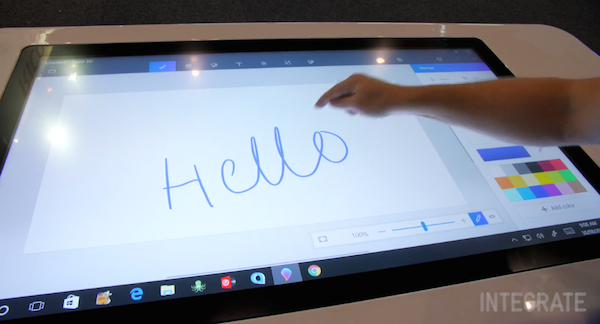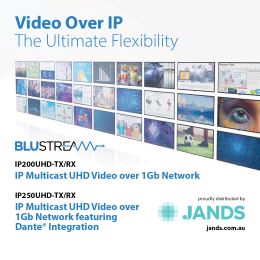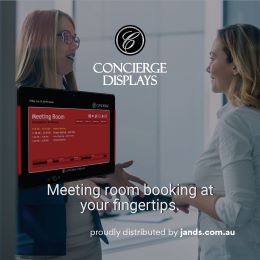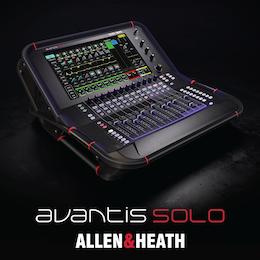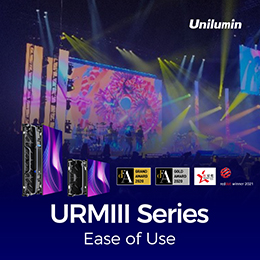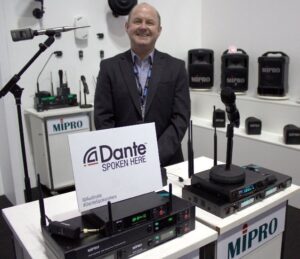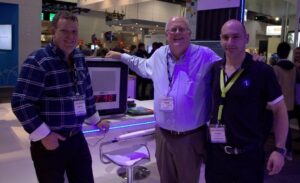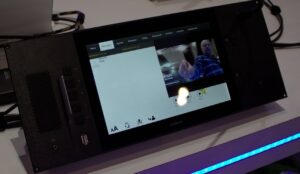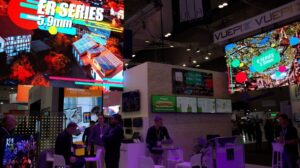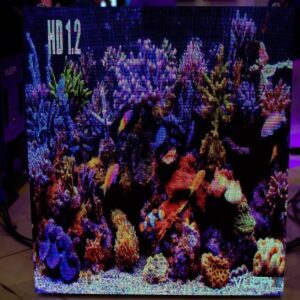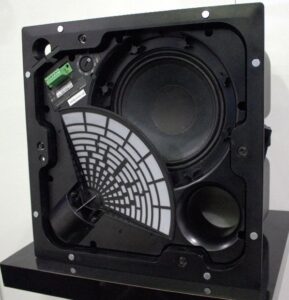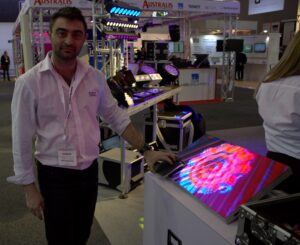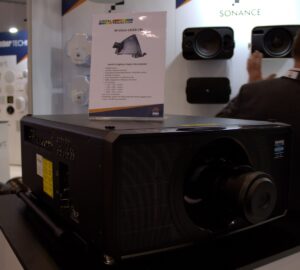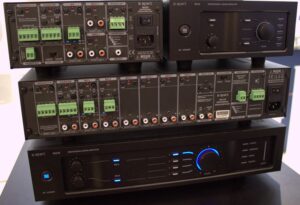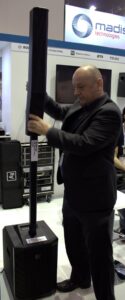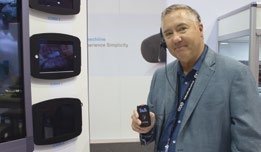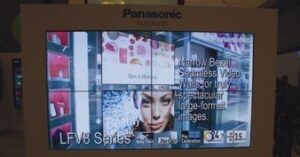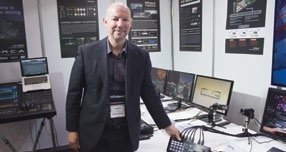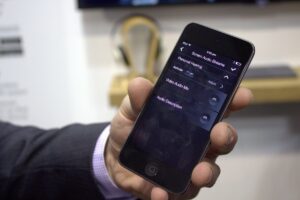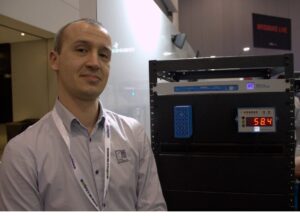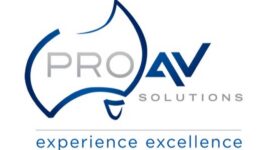Subscribe to CX E-News
TRADESHOWS
Integrate 2017 opened in Melbourne on 28 August with a queue at the door and a flood of visitors. After convergence has vanquished the large format matrix switcher, the next frontier in disruption is control – will we see a hardware-less future for our AV control systems? Jason Allen was on the show floor…
By Jason Allen.
Integrate 2017 attracted exhibitors, presenters, and visitors from across APAC, including some who were miffed that they couldn’t attend the clashing Musik Manilla in the Philippines, which just goes to show how wide Integrate’s reach has become. At the 2017 show, the future of AV is becoming clear, with Ingram Micro proudly displaying Microsoft products on their stand, while Microsoft’s Ian Heard moderated a 10:30 seminar on the ‘Workspaces of Tomorrow’. Elsewhere in the large and well-curated seminar programme, staff from Google are on the bill.
SOFTWARE IS THE NEW BLACK
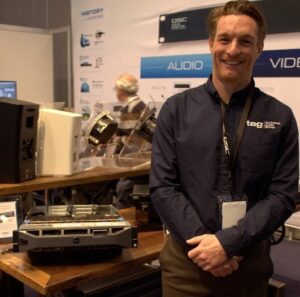 Over at Technical Audio Group, Ewan McDonald (pictured) proudly posed next to a Dell Server running QSC’s Q-SYS DSP and control software, and explained how the customer purchases it from Dell with Q-SYS pre-loaded; QSC provides end-points. The present is now beyond convergence – IT hardware is now replacing AV’s processing and control hardware, making us an industry of software licensers and end-point makers. To prove their point, TAG had set up a system that could order coffee via a touch screen and send you a text when it was ready – pretty nifty for what started out as an audio DSP.
Over at Technical Audio Group, Ewan McDonald (pictured) proudly posed next to a Dell Server running QSC’s Q-SYS DSP and control software, and explained how the customer purchases it from Dell with Q-SYS pre-loaded; QSC provides end-points. The present is now beyond convergence – IT hardware is now replacing AV’s processing and control hardware, making us an industry of software licensers and end-point makers. To prove their point, TAG had set up a system that could order coffee via a touch screen and send you a text when it was ready – pretty nifty for what started out as an audio DSP.
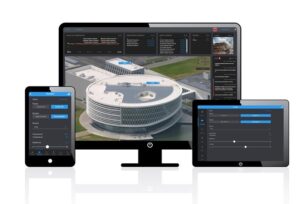 In a similar vein is Barco’s Overture. Last year, Barco purchased Canadian company Medialon, who had been making IP-based show control software for applications like theme parks for years, and have now repackaged their product as Overture. It’s an incredibly simple web interface that is so straightforward that almost anyone could use it to configure a networked AV system. It does everything the incumbents do with no special programming or coding required, and runs on off-the-shelf networking hardware as well. Some traditional AV manufacturers are acting like this isn’t happening, and we’ll see how that turns out.
In a similar vein is Barco’s Overture. Last year, Barco purchased Canadian company Medialon, who had been making IP-based show control software for applications like theme parks for years, and have now repackaged their product as Overture. It’s an incredibly simple web interface that is so straightforward that almost anyone could use it to configure a networked AV system. It does everything the incumbents do with no special programming or coding required, and runs on off-the-shelf networking hardware as well. Some traditional AV manufacturers are acting like this isn’t happening, and we’ll see how that turns out.
AROUND THE SHOW FLOOR
Audio Brands Australia showed off their new brand Mipro, the Taiwanese manufacturer with an incredibly broad range. New additions to their line-up included wireless mic systems with Dante connectivity. Well-known for their portable PA products, Audio Brands Australia were keen to showcase some of their lesser-known products, such as their tour guide systems.
Jands welcomed Robe and Anolis to their lighting portfolio, with new fixtures like Robe’s Spiider on display. The big news was from Shure, with three major new products on show. Shure’s new Axient digital wireless range is the flagship replacement for both the current analogue UR and Axient lines [see our coverage of product launch here]. The receivers and transmitters are all new, with the ADX model featuring automatic frequency management. Receivers come in dual or quad, with the quads capable of ‘Quadversity’ mode, where 4 antennas are combined for extra reach. All receivers are 24 bit 48kHz, with 120dB dynamic range, and come equipped with analogue, AES and Dante outs. A handy feature is the ability to listen to any Dante channel on the network via the monitor out.
Shure’s P300 IntelliMix Audio Conferencing Processor is a handy little box that pairs nicely with the MXA 910 ceiling array microphone. It’s got 10 Dante in and two out, two analogue in and out, USB in and out, and an extremely useful mobile input on a TRRS 3.5mm connection. Processing includes eight channels of AEC and automixing. It runs on PoE, making install a breeze.
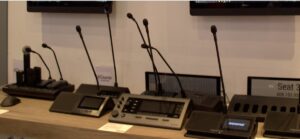 The Shure Microflex Complete conferencing system is a redesign of product acquired when Shure bought DIS (Danish Interpretation Systems). There’s cabled desktop and wireless conferencing panels, and up to 125 conference stations can run off their wireless access point with eight delgates talking at any one time. The range also includes a nifty double-sided E-paper display that can be used to text (names, for example) and images. They can be affiliated with a panel and activated by delegate card login, or have details loaded via USB.
The Shure Microflex Complete conferencing system is a redesign of product acquired when Shure bought DIS (Danish Interpretation Systems). There’s cabled desktop and wireless conferencing panels, and up to 125 conference stations can run off their wireless access point with eight delgates talking at any one time. The range also includes a nifty double-sided E-paper display that can be used to text (names, for example) and images. They can be affiliated with a panel and activated by delegate card login, or have details loaded via USB.
PAVT have secured distribution of AtlasIED, the American manufacturer with 85% of the US airport PA/paging market. Their product range includes visual paging, easy tie-in to flight info systems, and easy integration for common things like gate and baggage announcements. Their IP-addressable loudspeakers run PoE, and include visual displays and strobe lights for announcements. They easily interface with phone systems, VoIP, and Dante. AtlasIED is also one of the only AV manufacturers to be a Cisco Partner and is Cisco Certified. Televic’s uniCOS is a multimedia conferencing system that does real-time video capture and injection onto the network. With extremely low latency, each delegate can choose which video their display is receiving and send their camera feed out. The system also includes all the expected document loading and voting capabilities.
- PAVT’s Graeme Stevenson, Atlas IED’s Dean Standing and PAVT’s David Di Muzio
- Televic uniCOS
- ULA Group
- VuePix HD1.2
ULA Group dazzled with two massive VuePix LED screens, and showcased its HD1.2mm pitch panels. HD1.2 is convection cooled with no fans on board, and uses fast locks and positioning pins for easy alignment. There’s dual power and signal redundancy, with hot-swappable power and signal modules that can be serviced from either front or rear.
Bose launched the unique EdgeMax flush-mount ceiling speaker. It uses a proprietary phase guide and produces asymmetrical vertical coverage at 119dB continuous, which means you can cover a whole room with just units in the corners. When mounted, it shoots at a 90 degree angle directly down to cover below itself, but also shoots at a 15 degree angle across the room. Bose claims the performance as similar to a high-quality surface mount, with the advantage being you can cover a room with a fraction of the usual amount of ceiling or surface-mount speakers.
The big star on the Hills stand was L-Acoustics Syva, which looks beautiful and sounds amazing. Syva can produce 142 dB max SPL down to 35 Hz and throws 35 metres, at 140 degrees wide. The top box runs six 5” MF speakers and three 1.75” HF diaphragm compression drivers, loaded by DOSC waveguides in a J-shaped progressive curvature. There are two bottom boxes – the Syva Low and the Syva Sub. The Low enclosure features two K2 12” drivers while the Sub features one high excursion 12” driver equipped with a KS28 woofer motor. This system is going to be wildly popular in the corporate market, and anywhere else that cares about how their PA looks. [See our preview of Syva here.]
Eventec (formerly Event Lighting) brought their giant LED skull, but also were showing off their 1.2mm pitch front-serviceable LED panel with removable modules, as well as signage solutions, fog machines, and DJ booths.
Amber Technology unleashed Digital Projection’s massive new M-Vision LASER 18K, a single-chip laser source projector producing 18,000 lumens. Its DisplayPort input accepts frame rates up to 60 Hz and HDMI 1.4 for side-by-side, frame packing and top/bottom 3D formats. It runs at WUXGA resolution, has a 20,000 hour life, and includes motorised shift, zoom and focus across the whole lens range. Apart Audio MA Series mixer amps are cleverly designed from both the installers and end-users perspective. They’re available in four models and two sizes; 19-inch 240W or 120W, and 9.5-inch 60W or 30W. The front panel controls are extremely non-audio-type friendly, light up when selected, and are easily labelled. The rear panel is clearly thought-through and well set-out, with a very clever left-to-right four step priority system for ducking.
- Eventec’s Emanual Maniatis with their 1.2mm LED panels
- Digital Projection M-Vision LASER 18K
- Apart Audio MA Series
Bosch introduced the Electro-Voice Evolve 50 powered portable column speaker and sub, which clips together using an impressive magnetic system with no cabling. With a 120 degree wide and 40 degree vertical coverage pattern, the Evolve 50 can be used alone or paired. It’s powered by a 1000 W Class-D amplifier and has Electro-Voice’s QuickSmartDSP on-board. The system has three parts – a wooden, ported, powered subwoofer fitted with a 12” driver, the array running eight 3.5” neodymium drivers, and an aluminium pole that connects them, routing the signal internally.The processing engine gives you four presets (Music, Live, Speech, and Club), three-band EQ, five user-programmable presets (Store and Recall settings), output delay, phantom power (+15V), visual monitoring of limiter status, input level control and meters, and master volume control to ensure optimal gain structure. You can connect via the Electro-Voice QuickSmart app for control and monitoring, and stream via Bluetooth.
NAS were joined by Listen Technologies’ Russ Gentner with ListenTALK, a DECT-based two-way digital tour guide system with applications way beyond tours. Because of the two-way capability of each transceiver, ListenTALK could easily find a home in training sessions, intercom applications, interpretation, hearing augmentation, or press conferences. The system can be set up with ‘Leader’ and ‘Follower’ units with a range of 100 metres indoors and 200 metres outside. Up to 10 groups of systems can share the airwaves, with an unlimited number of ‘Listeners’ or ‘Followers’. Battery life is 8 hours for a talker or ‘Leader’, and 12 hours for a listener or ‘Follower’.
Panasonic displayed their PT-RQ32K, a 3-chip DLP, 4K, 27,000 lumen projector, and the PT-RZ21K 21,000 lumen chip DLP laser projector, both of which use the same lenses as their current 3-chip DLP projectors. Also on the stand was their impressive new 55” video wall display, the TH-55LFV8, which does 4K passthrough and can split the image out at 1080p to the other screens in the wall.
Roland’s tiny XS-1HD multi-format matrix switcher switches four sources to four outputs and runs 4:4:4/10-bit processing at up to WUXGA/1080p. It’s got a frame synchroniser and scaler on every input, and scalers on the outputs. There’s three operation modes; Matrix Mode allows switching of 4 sources to any of 4 outputs, Switcher Mode allows PinP, key-compositing, and dissolve transitions, and Split Mode allows PinP of up to three inset windows. Read our preview of the XS-1HD here
Sennheiser’s MobileConnect lets you stream low-latency audio over WiFi for exhibitions, tour guides, or the hard of hearing direct to their iPhone app. A recent firmware upgrade has added stereo operation, and now allows 100 users per MobileConnect server spread over two wireless access points. New pages on the app include a graphically non-threatening EQ and gain page that runs algorithms developed by Sennheiser with the Frauenhofer Institute.
Audio Logistics brought their new Procab cabling, including the premium pro quality Prime Series, which comes with Neutrik connectors. Also new was their distributorship of MRC Audio, a Spanish manufacturer of intelligent PA limiters. MRC Audio’s limiters feature multiband and multi-octave limiting, real-time monitoring, and the ability to compare their mic and line ins, which helps them differentiate between an actual increase in volume or just a punter yelling near the mic.
View integrate website for more images here
This article first appeared in the print edition of CX Magazine October 2017, pp16-21.
CX Magazine is Australia and New Zealand’s only publication dedicated to entertainment technology news and issues since 1991. Read all editions for free or search our archive for stories, people, tech-tips, products and production reviews www.cxnetwork.com.au
Subscribe
Published monthly since 1991, our famous AV industry magazine is free for download or pay for print. Subscribers also receive CX News, our free weekly email with the latest industry news and jobs.


